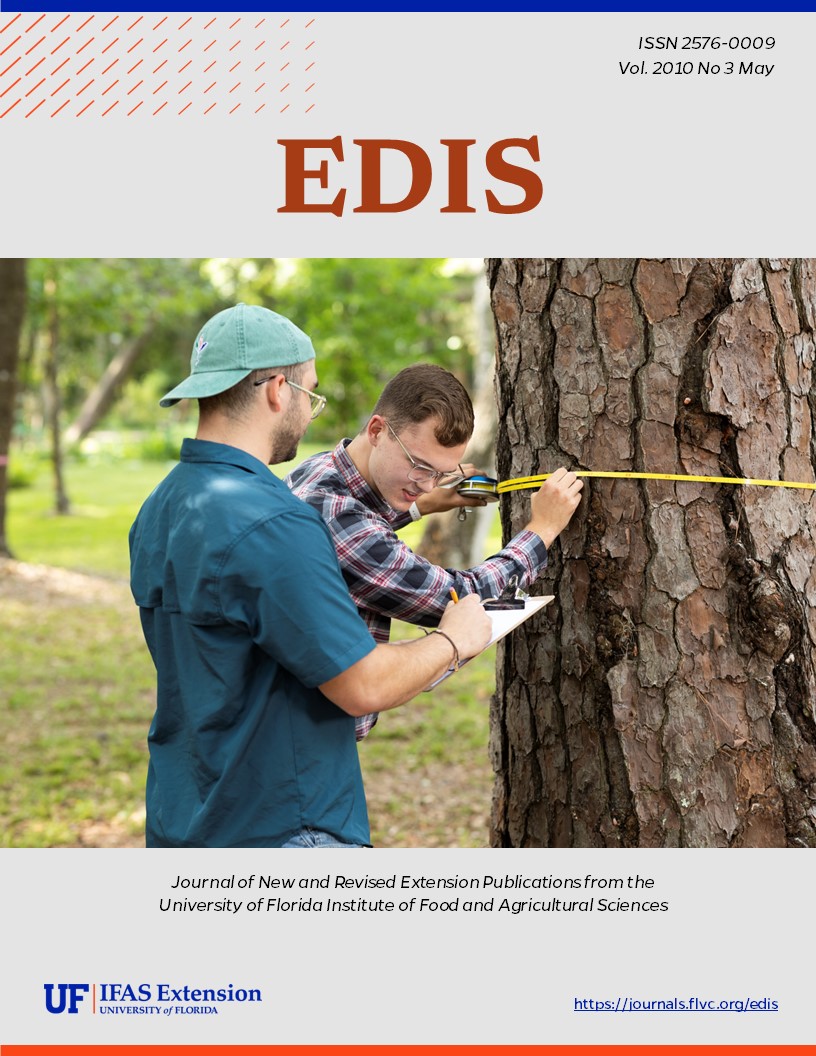Abstract
PP272, a 6-page illustrated fact sheet by Chenzhao Xie and Gary Vallad, guides vegetable growers to recognize and manage this serious fungal disease affecting diverse crops grown around the world, especially in tropical and subtropical regions — symptoms and signs, pathogen biology, disease cycle, epidemiology, and integrated management. Includes references. Published by the UF Department of Plant Pathology, March 2010.
References
Aycock, R. 1966. Stem rot and other diseases caused by Sclerotium rolfsii. Tech. Bull. 174. Raleigh: North Carolina State University Agricultural Experiment Station.
Bulluck L. R., and J. B. Ristaino. 2002. Effect of synthetic and organic soil fertility amendments on southern blight, soil microbial communities. Phytopathology 92:181-189. https://doi.org/10.1094/PHYTO.2002.92.2.181
Crow, W. T., and R. A. Dunn. 1994. Soil organic matter, green manures and cover crops for nematode management. ENY-059. Gainesville: University of Florida Institute of Food and Agricultural Sciences. http://edis.ifas.ufl.edu/VH037.
Culbreath, A. K., T. B. Brenneman, and R. C. Kemerait. 2009. Effect of the new pyrazole carboxamide fungicide penthiopyrad on late leaf spot and stem rot of peanut. Pest Management Sci. 65:66-73. https://doi.org/10.1002/ps.1646
Dukes, P. D., and R. L. Fery. 1984. Southern blight (Sclerotium rolfsii Sacc.) of pepper: Identification of resistance. Abstract. HortScience 19:212.
Ferreira, S. A., and R. A. Boley. 1992. Sclerotium rolfsii. http://www.extento.hawaii.edu/Kbase/Crop/Type/s_rolfs.htm#HOSTS.
Fery, R. L., and P. D. Dukes, Sr. 2005. Potential for utilization of pepper germplasm with a variable reaction to Sclerotium rolfsii Sacc. to develop southern blight-resistant pepper (Capsicum annuum L.) cultivars. Plant Genetic Resources 3:326-330. https://doi.org/10.1079/PGR200586
Krueger, R., and R. McSorley. 2009. Solarization for pest management in Florida. ENY-902. Gainesville: University of Florida Institute of Food and Agricultural Sciences. http://edis.ifas.ufl.edu/IN824. https://doi.org/10.32473/edis-in824-2009
Latunde-Data, A. O. 1993. Biological control of southern blight disease of tomato caused by Sclerotium rolfsii with simplified mycelial formulations of Trichoderma koningii. Plant Pathology 42:522-529. https://doi.org/10.1111/j.1365-3059.1993.tb01532.x
Leeper, P. W., S. C. Phatak, and B. F. George. 1992. Southern blight-resistant tomato breeding lines: 5635M, 5707M, 5719M, 5737M, 5876M, and 5913M. Hortscience 7:475-478. https://doi.org/10.21273/HORTSCI.27.5.475
Muchovej, R. M., E. A. Hanlon, E. McAvoy, M. Ozores-Hampton, F. M. Roka, S. Shukla, H. Yamataki, and K. Cushman. 2005. Management of soil and water for vegetable production in southwest Florida. SL-233. Gainesville: University of Florida Institute of Food and Agricultural Sciences. http://edis.ifas.ufl.edu/SS452. https://doi.org/10.32473/edis-ss452-2005
Mullen, J. 2001. Southern blight, southern stem blight, white mold. http://www.apsnet.org/Education/LessonsPlantPath/SouthernBlight/default.htm. https://doi.org/10.1094/PHI-I-2001-0104-01
Papavizas G. C., and J. A. Lewis. 1989. Effect of Gliocladium and Tricholdrma on damping-off and blight of snapbean caused by Slerotium rolfsii in the greenhouse. Plant Pathology 38:277-286. https://doi.org/10.1111/j.1365-3059.1989.tb02144.x
Pernezny, K., A. Gevens, T. Momol, A. Palmateer, N. Peres, R. Raid, P. Roberts, G. Vallad, and S. Zhang. 2008. 2008 Florida plant disease management guide: Chemical control guide for diseases of vegetables, revision no. 19. PPP6. Gainesville: University of Florida Institute of Food and Agricultural Sciences. http://edis.ifas.ufl.edu/PG100. https://doi.org/10.32473/edis-pg100-2008
Punja, Z. K. 1985. The biology, ecology, and control of Sclerotium rolfsii. Annual Review of Phytopathology 23:97-127. https://doi.org/10.1146/annurev.py.23.090185.000525
Punja, Z. K. 1986. Effects of calcium and nitrogen fertilizers, fungicides, and tillage practices on incidence of Sclerotium rolfsii on processing carrots. Plant Disease 70:819-824. https://doi.org/10.1094/PD-70-819
Punja, Z. K., and J. E. Rahe. 1992. Sclerotium. In: Methods for research on soilborne phytopathogenic fungi, ed. L. L. Singleton, J. D. Mihail, and C. M. Rush, 166-171. St. Paul, MN: American Phytopathological Society Press.
Ristaino, J. B., K. B. Perry, and R. D. Lumsden. 1991. Effect of solarizaton and Gliocladium virens on sclerotia of Sclerotium rolfsii, soil microbiota, and the incidence of southern blight of tomato. Phytopathology 81:1117-1124. https://doi.org/10.1094/Phyto-81-1117
Rivard, C. L., F. J. Louws, S. O'Connell, and M. M. Peet. 2009. Grafting tomato with inter-specific rootstock provides effective management for southern blight and root-knot nematodes. Abstract. Phytopathology 99:S109.
Subbarao, K. V., S. T. Koike, and J. C. Hubbard. 1996. Effects of deep plowing on the distribution and density of Sclerotium minor sclerotia and lettuce drop. Plant Disease 80:28-33. https://doi.org/10.1094/PD-80-0028
Tu, C. C., and Kimbrough, J. W. 1978. Systematics and phylogeny of fungi in the Rhizoctonia complex. Botanical Gazette 139(4): 454-466. https://doi.org/10.1086/337021
U.S. Environmental Protection Agency. 2009. The phaseout of methyl bromide. http://www.epa.gov/Ozone/mbr.
Woodward, J. E., T. B. Brenneman, and R. C. Kemerait, Jr. 2007. Use of resistant cultivars and reduced fungicide programs to manage peanut diseases in irrigated and nonirrigated fields. Plant Disease 92:896-902 https://doi.org/10.1094/PDIS-92-6-0896

